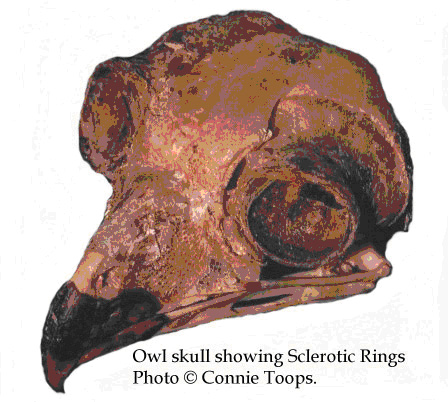The forward facing aspect of the eyes gives a Barn Owl a wide range of "binocular" vision. This means the owl can see objects in three dimensions (height, width, and depth), a talent not available to birds with side-mounted eyes. The field of view for an owl is about 110 degrees, with about 70 degrees being binocular vision. By comparison, humans have a field of view that covers 180 degrees, with 140 degrees being binocular. A Barn Owl's eyes are large in order to improve their efficiency, especially under low light conditions. In fact, the eyes are so well developed, that they are not eye balls as such, but elongated tubes.
Cross-section of an owl’s eye.

They are held in place by bony structures in the skull called Sclerotic Rings.

For this reason, a Barn Owl can only look straight ahead. But it has fourteen vertebrae in its neck while you and I have seven. This allows the owl to turn its head through a range of 270 degrees something I envy while backing up my car. The retina of an owl's eye has an abundance of rod cells that are sensitive to light and movement, but do not react well to color, and few color-sensitive cone cells so they see mostly in monochrome.
Because Barn Owls are generally active at night, they have highly developed hearing. The ears are located at the sides of the head, behind the eyes, and are covered by the feathers of the facial disc. The Barn Owl’s range of audible sounds is not unlike that of humans, but its hearing is much more acute enabling it to detect even the slightest movement of their prey in leaves or undergrowth. Barn Owls have one ear higher than the other. Their pronounced facial disc acts like a "radar dish", guiding sounds into the ear openings. The shape of the disc can be altered at will, using special muscles. When a Barn Owl hears a noise, it is able to tell the direction because of the minute time difference in which the sound is perceived in the left and right ear. The Owl then turns its head so the sound arrives at both ears simultaneously - then it knows the prey is right in front of it. Owls can detect a left to right time difference of 30 millionths of a second.
A Barn Owl can also tell if the sound is higher or lower by using the asymmetrical or uneven ear openings. The left ear opening is higher than the right - so a sound coming from below the line of sight will be louder in the right ear. The translation of left, right, up and down signals are combined instantly in the Barn Owl's brain, and create a mental image of the space where the sound source is located. Once the Barn Owl has determined the direction of its next victim, it will fly toward it, keeping its head in line with the latest sound the prey creates and making corrections mid-flight. When about two feet from the prey, the Barn Owl will bring its feet forward and spread its talons in an oval pattern to increase the chance of a successful strike.
Unlike other birds, the comb-like feather edge effectively muffles the sound of the air rushing over the wing surface and allows the owl to fly silently, stealthily and to use its hearing to locate potential prey.
As Mrs. Wheelock wrote in 1904 and Arthur Cleveland Bent noted in his “Life Histories of North American Birds of Prey”, once seen or heard, a mouse has little chance of escape from such a well equipped hunter. Bent’s book first published in 1938, and its companions, are favorites on my book shelf to this day.
BBack to ... Mendocino Coast Audubon Society Newsletter Articles | Home page